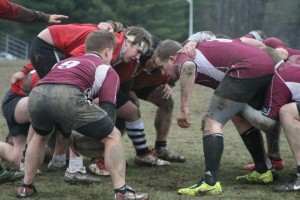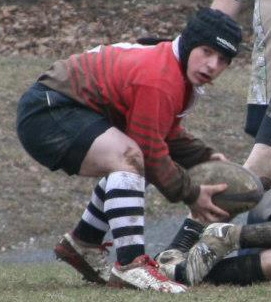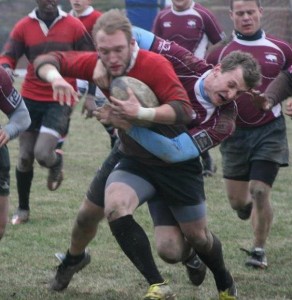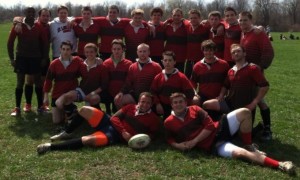The next generation at NCPR: Part 2, Rugby
In this piece from the second of our summer interns, St. Lawrence University junior Josh Cameron talks about his passion for rugby. –Ellen
I just want to clarify: I have always been a football guy through and through. I have played since 6th grade and have followed the NFL, especially my dear Cowboys, like a religion. One of my dreams has been to coach football some day. Never once in my life did I think I could love a sport any more, but now I am not so sure.
I am a Rhetorical Communications major and Sports Studies and Exercise Science minor and the president of the Rugby Club, and I’d like to tell you about Rugby. If you have ever seen the movie Invictus, starring Morgan Freeman as Nelson Mandela, you may know a little bit already.
There are two types. Rugby Union and Rugby League. Union is the most common and generally what you will see. In Rugby Union, each team is allotted 15 men on the field and only 7 substitutes for the whole 80 minute game. This is counting injuries. If you have to come off the field because you’re injured, it costs your team a substitution.

Figure 2. St. Lawrence Deadcats lining up for a scrum against the Cortland Herd. Photo: Kristen Walsh
Many say that rugby is the perfect combination of soccer and football. Take the endurance needed to play an 80 minute soccer game, where you are constantly on the move. Then, add the constant physical contact of football. Oh, and we don’t wear pads. What you see on my head in Figure 1. is a scrum cap. Some rugby players (ruggers) wear these to protect their ears and heads, especially forwards. At the forward position, there is a higher chance for your ears to be damaged or for your head to be cleated. A lot of ruggers use metal cleats.
Postitions are broken down into forwards and backs. Each position has its own number. For instance, I am a forward. My position is called hooker and I wear the number two. When the ball is thrown down the tunnel in a scrum (Figure 2.), I have to ‘hook’ the ball with my feet and send it back towards the scrum half. The hooker has one of the most dangerous jobs because all the pressure of the scrum is put onto one leg. When engaged, if the scrum collapses, it could cause severe neck damage to him or her (yes, there is women’s rugby and they play the same way). This is why the props (the two men supporting me in Figure 2) are so important. Being able to communicate with the props is vital, but most importantly, you have to trust them.
Backs do not compete in scrums, but they can compete in Rucks. A ruck is formed when two or more opposing players engage over top of a downed ball carrier. The ball carrier must release the ball when down. The main job of a back is to be fast, run hard, kick well, and most importantly score. There are two ways to score in rugby. A try is like a touchdown in football and is worth five points. To score a try, the runner must touch the ball to the ground in the try zone. After the try, there is an extra kick worth two points. You can also score by dropkicking the ball while in play. If it goes through the uprights, you get three points. This is similar to a field goal in football.
Rugby is the perfect game for the best of both the soccer and football worlds. If you have any questions about Rugby rules, regulations, or about our club, feel free to comment or send an email to me, [email protected]. Most importantly, support your local rugby clubs!
The St. Lawrence Rugby Club has just returned after a five year ban imposed because of a hazing incident. As the new president of the Club, I am working to bring the team back as a positive athletic force on campus. To do so, we need as much support as we can get. The best way to learn about the game is to watch our matches, and check out articles like this one from NCC Online.
Rugby is on the rise in the United States. I know it’s not the most popular American sport, but it’s become my passion.
What’s your sports passion? Please tell me about the sport you most enjoy watching or playing.
You can also view this post on my new, weekly blog page Napoleon’s Nook! (blogspot.com)
For a basic explanation of the rules of rugby and more detailed explanation of terms, check out this great instructional video.
Tags: rugby, St. Lawrence University











Two important points –, forward passing is prohibited and there is no blocking. Although it looks rough, the only tackling that goes on is to the guy with the ball. (So you play hot potato within the team) That limited injuries. Our university of 35,000 only had a Rugby club rather than a school team but we had international students, professors, grad students and local professionals on the club. There was no hazing, they did like their beer but never teased anyone who didn’t partake. It is the only time I played an organized sport but I enjoyed the game and the civility of the team… well as best can be had in such a game.
We only substituted if there was an injury. Played wing and fly.